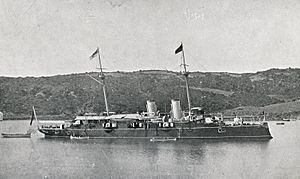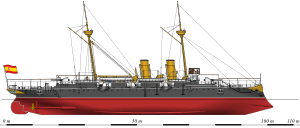Spanish cruiser Alfonso XIII facts for kids
 |
|
Quick facts for kids History |
|
|---|---|
| Name | Alfonso XIII |
| Namesake | King Alfonso XIII of Spain |
| Builder | Naval shipyard at Ferrol, Spain |
| Cost | 9,000,000 pesetas |
| Laid down | 1891 |
| Launched | 31 August 1891 |
| Completed | nominally (as training ship) 1896; fully completed 18 May 1900 |
| Commissioned | 18 May 1900 |
| Fate | Scrapped in early 1900s |
| General characteristics | |
| Class and type | Reina Regente-class protected cruiser |
| Displacement | 4,725 tons |
| Length | 317 ft 0 in (96.62 m) |
| Beam | 50 ft 0 in (15.24 m) |
| Draft | 20 ft 4 in (6.20 m) mean |
| Installed power | Rated at 11,500 ihp (8,600 kW) (forced draft); actual power much less |
| Propulsion | 2-shaft, horizontal triple expansion |
| Speed |
|
| Endurance | Coal 1,200 to 1,285 tons (normal) |
| Complement | 440 officers and enlisted |
| Armament |
|
| Armor |
|
The Alfonso XIII was a special type of warship called a protected cruiser in the Spanish Navy. It was named after King Alfonso XIII of Spain. This ship served in the Spanish fleet from 1896 until the early 1900s.
Building and Design of the Ship
The Alfonso XIII was built in Ferrol, Spain, at a naval shipyard. Its construction started in 1891, and it was launched into the water on August 31, 1891.
Even though it wasn't fully finished, the ship began service in 1896 as a training ship. This meant it was used to teach sailors. It was finally completely ready and officially joined the navy on May 18, 1900.
The designers wanted this ship to have powerful weapons and be very fast, but also not too big. However, there were some problems. Another ship of the same type, the Reina Regente, was a bit wobbly. Changes were made to Alfonso XIII to fix this, like giving it smaller main guns. But these changes didn't work as planned. The Alfonso XIII ended up being lightly armed, quite slow, and still not very stable in rough seas.
The ship had four large 7.9-inch (201 mm) guns, placed at the front and back on the sides. It also had six smaller 4.7-inch (120 mm) guns in the middle. For close combat, it carried six quick-firing 6-pounder guns and six machine guns. It also had five torpedo tubes, which were fixed in place above the water. Two were at the front, one on each side, and one at the back.
Life at Sea
As mentioned, Alfonso XIII was still being built when it started service as a training ship in 1896. It was not fully ready when the Spanish–American War began.
In May 1898, during the war, the ship was sent to Cadiz to join a group of Spanish warships. This group was planning to sail to the Philippines. However, because Alfonso XIII was not complete, the admiral decided to leave it behind. The ship stayed in Spanish waters for the rest of the war. Its job was to help protect Spain's coast from any possible attacks by the United States Navy.
After the war ended, Alfonso XIII was finally completed and officially joined the navy on May 18, 1900. But because of its design problems, especially its instability at sea, it didn't serve for very long. It was soon taken out of service and broken up for scrap metal.
See also
 In Spanish: Alfonso XIII (1896) para niños
In Spanish: Alfonso XIII (1896) para niños


